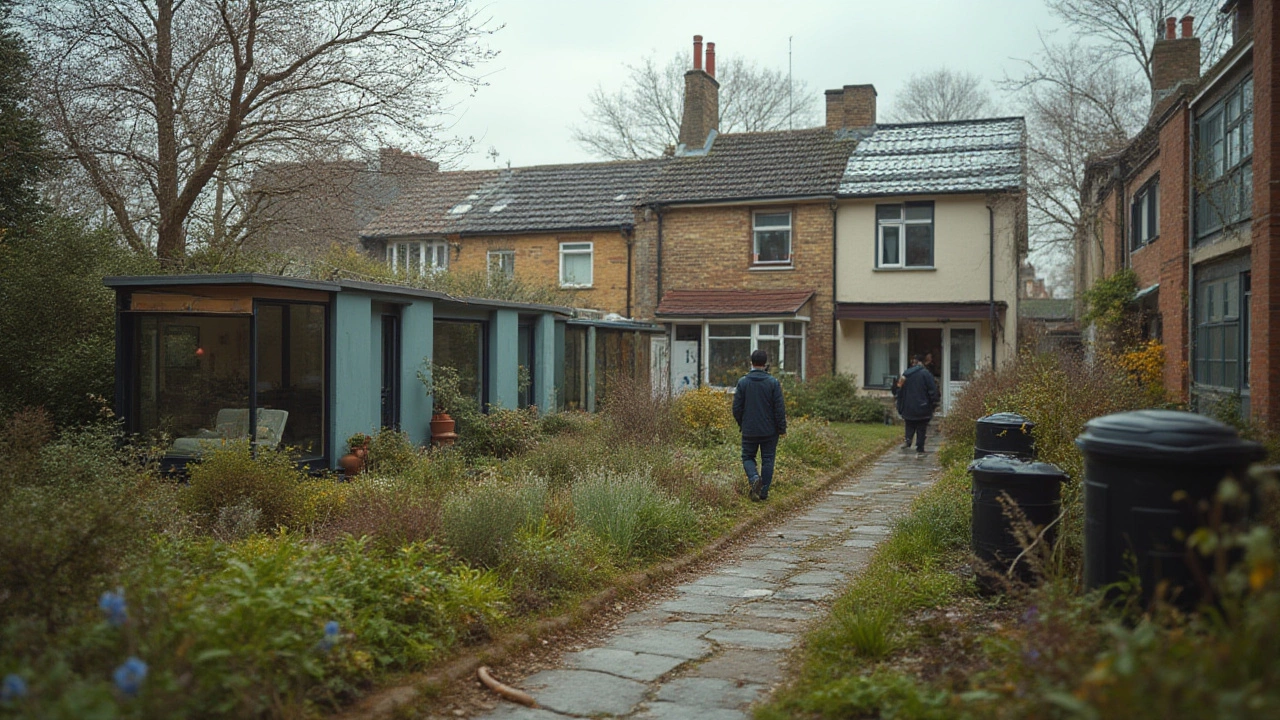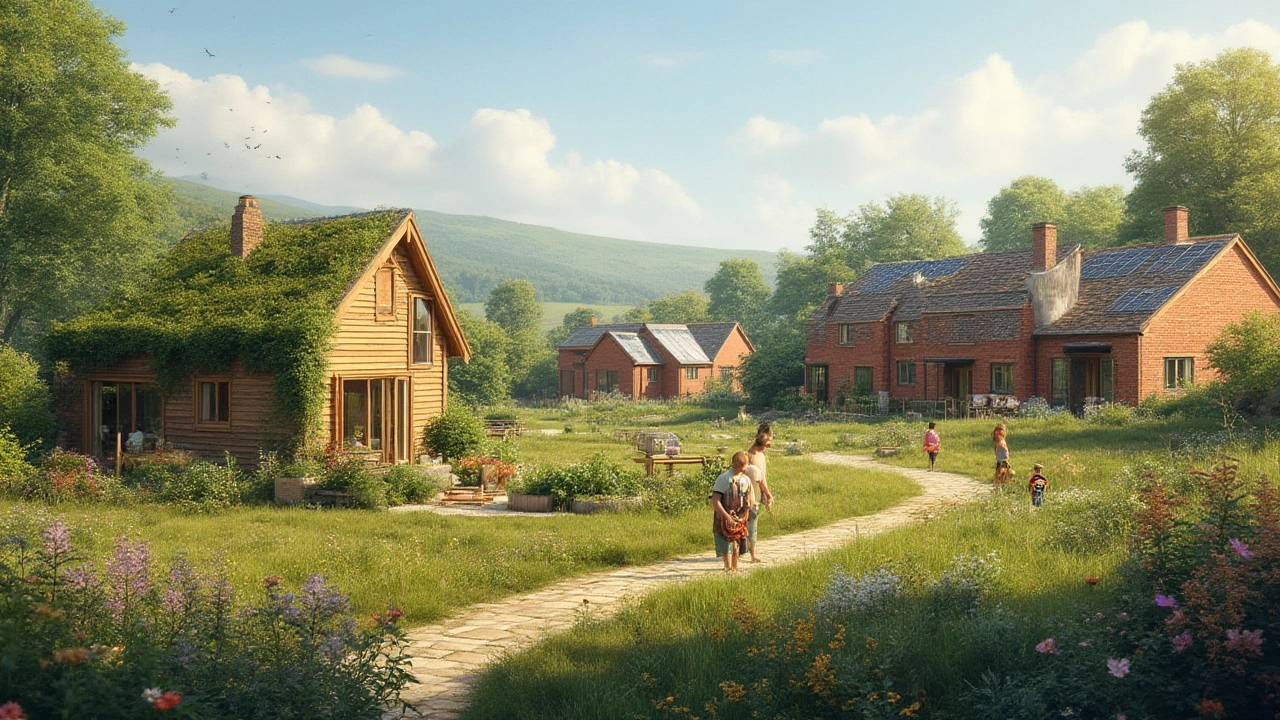Picture a home that actually gives more than it takes: a house that doesn’t just sit in its environment, but actively cares for it. Today, folks want to shrink their carbon footprints—not just with shopping bags, but right down to their walls and roofs. People everywhere are rethinking what their house can be. The 'perfect home' isn’t about size, curb appeal, or even fancy features. The race is on to answer a simple-but-huge question: what is the absolute most environmentally friendly way to live?
What Makes a Home Truly Eco-Friendly?
Eco-friendly homes go way beyond tossing a few solar panels on the roof. The real magic is in the full picture: how much energy you use, where your building materials come from, how you heat and cool your space, even how much water you’re flushing down the loo. Some of the greenest homes on earth are designed around a tight list of ‘musts’—low impact construction, renewable energy, minimal waste, and little to no pollution.
One key thing: location does matter. A straw-bale house in rainy Wales will face different challenges (and perks) than a timber cabin in dry Utah. The materials, design, and even orientation of a home decide just how green it can be. Passive houses, for example, focus on working with their natural surroundings—a building might face south to soak up sun or be built half underground to stay cool in summer. Some materials—like locally-made bricks, reclaimed wood, or bamboo—dramatically lower transport emissions and use less fossil fuel to produce. Earthships, a housing style born in New Mexico in the 1970s, use creatively re-purposed waste (think tires packed with compacted earth and empty glass bottles for walls). This doesn’t just look cool, it slashes resources and keeps trash out of landfills.
Water is a big story, too. Most eco-friendly homes aim for 'net zero' water use; rainwater collection, greywater recycling, and water-efficient appliances are all the rage. Heat and cooling account for most of a home’s energy use, so green homes are typically super-insulated. Triple-glazed windows, airtight doors, and a smart ventilation system cut heat loss so well, you can heat the house with a hair dryer (not literally, but close).
Construction itself can be a carbon monster. Concrete, for example, is responsible for about 8% of global CO2 emissions—yikes. New builds avoid it where they can, or use alternatives like hempcrete. Hempcrete acts as a natural insulator, stores carbon as it cures, and is fire/moisture resistant. Architects behind the world's lowest-energy builds favor wood for one big reason: trees soak up carbon while they grow. Mass timber and cross-laminated timber buildings are rising fast, even in cities like London and Toronto.
Of course, a home is only as green as the lifestyle inside it. Smart thermostats, LED lighting, composting toilets, and high-performance appliances stack up the gains. But don’t forget, keeping a home small and well-designed packs the biggest punch. Tiny homes are exploding in popularity for good reason—they use just a fraction of the materials, demand less energy, and often encourage a low-impact lifestyle simply because there’s less space for clutter and excess 'stuff.' Think about a typical American home, clocking in at nearly 2,500 square feet, versus a 350-square-foot tiny house on wheels. The smaller space wins every time.

Eco-Friendly Housing Types That Actually Work
If you’ve heard the hype around highly insulated 'passive houses,' you’re not alone. Passive House, or Passivhaus (the German standard), is all about airtightness. In fact, these homes can slash heating needs by up to 90% compared to a regular house. Every inch, from window frames to ductwork, is designed to keep energy use to a bare minimum. It isn’t just about saving cash (although you will!); it’s about shrinking your environmental impact so much that you barely leave a mark.
Earthships sound like something from a sci-fi film, but they exist all over the world, from Arizona to Belgium. The original earthship blueprint involves thick walls made of rammed-earth tires, strategic positioning for maximum sun, and built-in systems for water reuse and food growing. Some earthships are so efficient they need almost no outside power or water. These homes are big favorites with off-grid enthusiasts but have gone a bit mainstream too—if you can handle a look that’s a little wild and unconventional.
Tiny houses are more than a TikTok trend. Moving into a micro-home (usually under 400 square feet) means you automatically use far fewer building materials and far less energy. Many tiny homes are built with reclaimed wood, second-hand windows, and energy-efficient appliances. Just last year, a tiny home village in Vermont reported cutting average resident utility bills by over 70% compared to normal-sized rental apartments, simply because there’s so little space to heat and light. But, tiny living isn’t for everyone—some need more space or just like entertaining guests without stepping on toes.
Straw-bale construction is making a comeback, especially in cooler, drier climates. Straw is usually leftover from wheat harvest—cheap, renewable, and surprisingly fire resistant when packed tight. The thick bale walls act like a thermal blanket, holding in heat in winter and keeping cool in summer. One fun fact: a straw-bale house in Nebraska has survived since the 1920s, outlasting many 'modern' builds.
Container homes bring a whole different kind of recycling energy. Old shipping containers are transformed into living spaces, upcycled into sleek apartments, studios, or even stacked into family homes. Because you’re reusing metal boxes that would otherwise rust away, the environmental impact is much lower—especially if you insulate them properly and top them with a green roof. Speaking of green roofs: these are roofs planted with grass or sedum, acting as insulation and boosting biodiversity. In cities, one rooftop garden can bring down the temperature by several degrees during a heatwave and soak up stormwater that would otherwise flood the street.
Don’t skip modular homes—they’re built in a factory and shipped to your plot, which slices construction waste by up to 80%. The controlled environment means fewer delays, better recycling, and much tighter energy efficiency. One Swedish study tracked carbon emissions from different housing types and found modern modular wooden homes beat out almost every alternative for both embodied carbon and energy use later on.
Finally, let’s talk about the most ancient eco-home style: adobe. Adobe (mud brick) homes are low-cost, low-tech, and wildly resilient in hot, dry areas. Because they use earth from the building site, their footprint is microscopically small. Plus, thick mud walls keep things naturally cool—no blasting air conditioning for most of the year.

How to Make Any Home Greener—Without Starting From Scratch
Maybe moving into a straw bale palace isn’t in the cards, or the thought of sleeping inside shipping containers gives you the creeps. You don’t have to start from nothing to make a real difference. The easiest wins? Insulation, energy efficiency, and water use. Replacing old single-glazed windows with double or triple glazing will lower heating bills—and carbon emissions—overnight. Add insulation to your attic, seal up drafts, and switch old lightbulbs for LEDs. These changes pay themselves back quickly. Smart thermostats like the Nest or Ecobee learn your routine and can cut heating and cooling costs without losing comfort.
Solar panels are everywhere these days, with prices falling nearly 90% since 2010. Even a small array can provide enough energy for all your lights and devices. If rooftop solar isn’t an option, communities in Denmark and Germany have proved the power of shared solar microgrids. In the UK, even a simple solar water heating panel can cover half a family's hot water needs every year.
Water waste can be cut with a few clever swaps: installing low-flow faucets, dual-flush toilets, and a rainwater barrel for the garden. Greywater recycling systems, which let you water plants or flush toilets using water from your shower or washing machine, are turning up in more urban homes. In Melbourne, a basic rainwater system can save up to 40,000 liters per household per year—a number that would shock anyone still relying on lawn sprinklers.
Material choices matter more than most people realize. Next time you renovate, hunt for reclaimed or recycled materials—old barn wood, antique bricks, salvaged doors. Not only do these look gorgeous (and definitely unique), but they also keep usable stuff out of landfills. For insulation, wool or cellulose (often made from recycled newspaper) outperforms fiberglass in many climates and doesn’t itch like the devil.
Another tiny shift? Switch up landscaping for something drought-resistant. A front yard that sips water (think native grasses, wildflowers, or succulents) instead of guzzling gallons is a huge improvement, especially in dry regions. Permeable paving stones let rain soak down rather than running off into gutters, which keeps local streams healthier. Installing a green or "living" roof might sound ambitious, but even a small patch of rooftop plants can help insulate an older house and provide habitat for birds and bees.
Don’t forget the power of habits. Air-drying clothes, unplugging devices, composting food scraps, and simply buying less new stuff all add up. A big house can still run on very little energy if it’s used thoughtfully—zone heating, shutting unused rooms, and running appliances off-peak. Strangely enough, some of the greenest homes aren’t new at all, but lovingly restored old cottages or townhomes, retrofitted to modern standards for efficiency.
There’s not one single answer to the question, 'What’s the most eco-friendly type of housing?' It’s a moving target—what matters most is using what you have wisely, building or living with care, and never underestimating the power of small shifts stacking up over time. Whether you’re dreaming of an earthship or just want to shrink your next utility bill, every positive step matters in the big, complicated puzzle of sustainable living.
